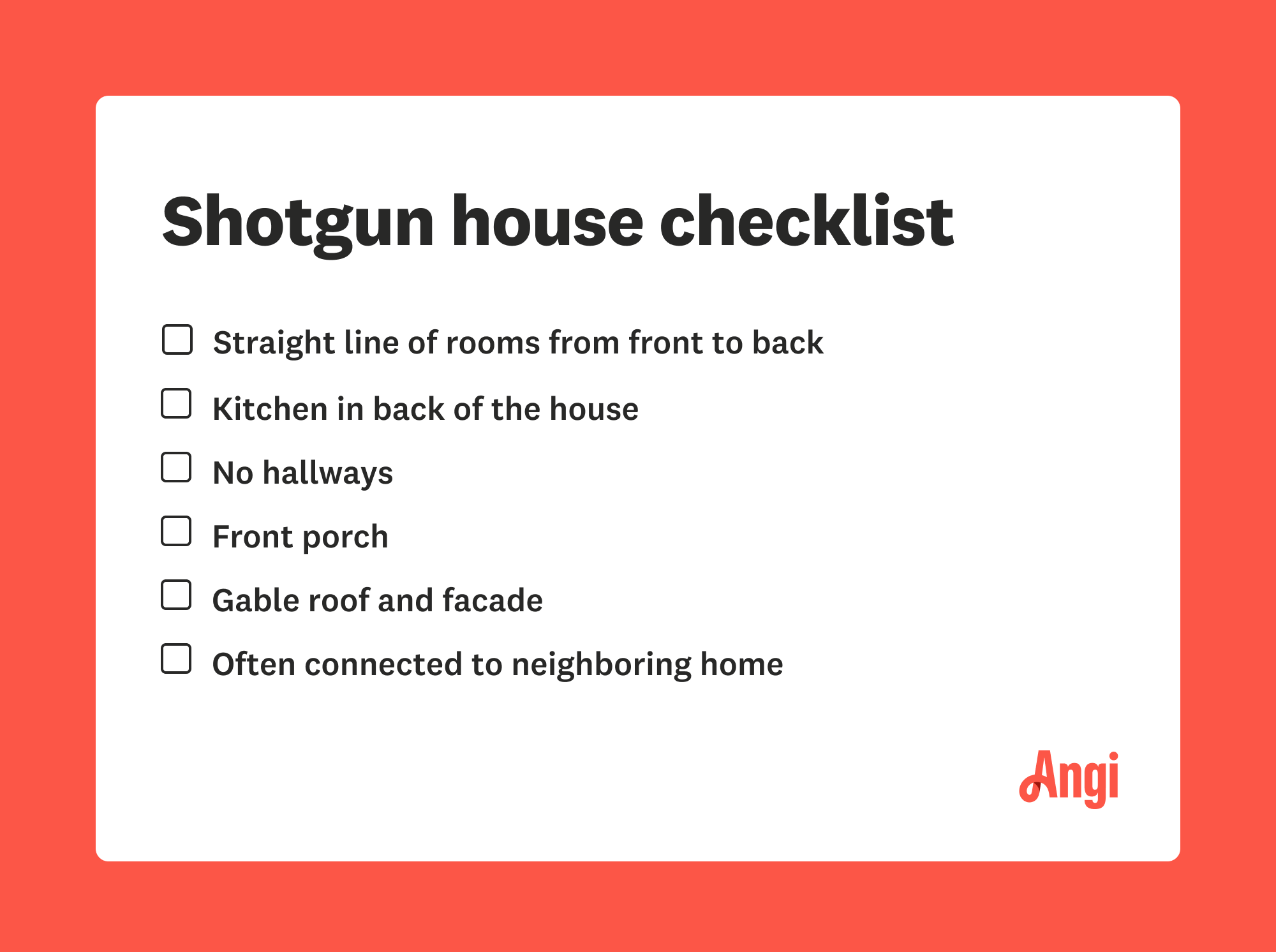Everything You Need to Know About a Shotgun-Style House
Hit the target for your historic home search by checking out the original tiny house of the South


Shotgun homes have a long, narrow layout with all rooms lined up in a row.
The style goes back to the early 19th century.
The layout encourages airflow in hot climates.
You'll still find shotgun houses across the South.
If you’re looking to unlock some historical secrets, the shotgun-style house will greet you on the streets of New Orleans, Louisville, Charlotte, or Houston and comes with over 200 years of stories to tell. But what is a shotgun house, and how do you know if you live in one? Here's what you need to know about the cherished Southern design.
What Is a Shotgun House?
The term “shotgun house” refers to an architectural home style traditionally found in the deep South, Texas, and along the southern Atlantic coast. These thin and long homes are typically one room wide and several rooms deep and are much easier to spot than their arts and crafts-styled home cousins. The style connects a series of rooms, one after another, from the front porch to the back door. In many cases, shotgun houses also attach to the home next door, a bit like a row home or brownstone townhouse.
The Preservation Resource Center of New Orleans discusses the shotgun house's still-debated history, but most historians believe the style stems back to the early 19th century along the Mississippi River. One theory explains that homebuilders saved money when packing as many homes into one plot as possible by avoiding high-income taxes, using minimal building materials, and offering affordable housing.
Other historians note that the style came with immigrants from modern-day Haiti and that the shotgun style blends West African and West Indian architecture.
Why Is It Called a Shotgun House?
Shotgun houses have one of the more intriguing names of all the architectural home styles. There are several theories of its background. The National Park Service explains that it may come from the Yoruba word togun, which translates to "place of assembly."
The other primary theory about the name comes from the idea that you can fire birdshot from the front door to the back without hitting a wall.
The Shotgun House Floor Plan
Original shotgun houses have an obvious and predictable layout that gives them their name. A front porch leads through the front door to a living area, one or two bedrooms, and a kitchen, all lined up in a row.
This means you have to cut through two bedrooms to get to the kitchen, which, as you can imagine, is not ideal for privacy. However, the layout does encourage smooth airflow in a hot and humid climate before the days of AC and electric fans.
Key Structural Elements of Shotgun Houses
In addition to its layout, there are a few ways to pick out a shotgun house on your tour of historic homes. For one, all rooms in a shotgun home are on a single floor and have extended front porches ideal for hosting.
The house sits perpendicular to the road, so you'll only see a small facade but not how far back it extends into the plot. In many cases—though not all—shotgun houses attach to the houses alongside it and only include windows on the front and back.
The majority of shotgun homes have gable roofs, which means they peak at the top with two evenly sloping sides.

Architectural Styles of a Shotgun House

In the early 20th century, shotgun houses fell out of favor due to their packed layout and the repetitive look they gave to a street, making way for popular ranch houses and small and stylish bungalows. Yet, the remaining shotgun houses show off a surprisingly large array of architectural styles. Drive through any historic district of their southern hometowns, and you'll find shotgun houses with:
Victorian or Eastlake gingerbread trim
Simple, monochromatic facades
Apron roofs
Italianate facades
Spanish or Greek revival elements
The Double Shotgun House
Double shotgun houses spread throughout its home cities as well, connected two long living spaces with one porch. In these cases, you will find two doors on one structure that share an outdoor hosting space.
Changes to the Shotgun House
The style was adapted over the years, adding plumbing, HVAC systems, and even hallways to accommodate new homeowners. But historically preserved homes typically kept the ornate style of these often colorful rows of houses.
Pros and Cons of a Shotgun-Style House
Even though shotgun houses failed to impress the trends of the early 20th century, many of these quaint abodes survived the test of time in areas like the New Orleans Garden District. If you're debating nabbing one of these historic buildings, here are some pros and cons to remember.
Pros
Excellent airflow: Shotgun houses are built for great ventilation. Even without an advanced HVAC system, you'll enjoy a cross breeze from the front to the back of the house
Compact size: With the rise of the tiny home, a small space with little to care for now makes the pro list for many homeowners.
Flexible design: Without a set living room, dining room, and bedroom, arrange the first two or three rooms however you please.
Cons:
History restrictions: When purchasing any old fixer-upper, remember that you may need the approval of a local historic board to make upgrades and alterations.
Minimal privacy: Make sure you're ready to get pretty cozy with your housemates before opting for a shotgun house. The layout makes it nearly impossible to sneak in after a late night without waking your roommate in the first bedroom.
Lack of land: Original shotgun homes used a good deal of space on their small plots. You're less likely to have a driveway, front yard, or ample backyard hosting space.
If you're embarking on a new life in a historic shotgun home, be sure to have an experienced local architect on your side. These pros will recommend historic facade alterations that won't threaten the character of its original charm and offer suggestions on improving energy efficiency.
How to Incorporate Shotgun Style Into Your Home
If you have no desire to move in the foreseeable future but you’d love to add some of a shotgun house’s charm to your home, here are a few tips:
Knock down a wall (or two): One of the unique features of a shotgun home is its openness. Consider removing a non-bearing wall or two to create an open-concept floor plan to add this feature to your home.
Focus on flow: These homes are built to flow smoothly between rooms. And if removing walls isn’t possible, consider arranging your furniture to flow in one direction so it’s not clunky to move around. Also, consider rearranging your home’s layout to improve its flow.
Add mirrors: Mirrors can give the illusion of more open space and an airy feel, typical in shotgun homes.
Use vibrant colors: Some shotgun homes are easily identifiable by their vibrant exterior colors, a homage to their Victorian roots. An easy way to incorporate this style into your home is by adding pops of colors on the exterior.
Add corbels to your home’s exterior: A more subtle nod at shotgun homes, but it can give it that shotgun-styled look.
Frequently Asked Questions
Yes, people still live in shotgun homes, mainly in the South. Many homeowners love historic houses, which are always full of character, so they continue to be a popular housing choice. Another reason is that they make excellent starter homes due to their size and price. Plus, who doesn’t love a good energy-efficient home?
There are a few different reasons why shotgun houses have two separate front doors. Shotgun homes with two front doors are also called double shotgun homes, which can be two individual homes that share a wall. Other reasons include improved ventilation throughout the home and better access to other rooms.





- 23 Popular House Styles: Architectural Designs and Their Unique Features
- 11 Handy Tips and Tricks to Help With Your Next Home Project
- Everything You Need to Know About an Earth House
- What to Do After a House Fire: 8 Steps for Home Fire Recovery
- 33 Front Porch Decorating Ideas to Welcome You Home
- Why Water is Leaking Through Your Sliding Glass Door and How to Stop It
- What Is an A-Frame House? Everything You Need to Know
- What Is the Best Temperature to Set Your Air Conditioner to in the Summer?
- What Permits Do Homeowners Need for Home Additions?
- 11 Home Heating Mistakes You Didn't Know Were Costing You










